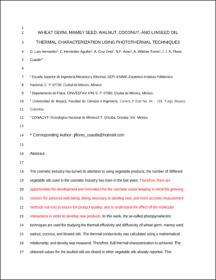Mostrar el registro sencillo del ítem
Wheat germ, mamey seed, walnut, coconut, and linseed oil thermal characterization using photothermal techniques
| dc.contributor.author | Lara Hernandez, Gemima | |
| dc.contributor.author | Cruz Orea, Alfredo | |
| dc.contributor.author | Arias Duque, Nayda | |
| dc.contributor.author | Flores Cuautle, Jose de Jesus Agustin | |
| dc.date.accessioned | 2021-05-13T23:12:06Z | |
| dc.date.available | 2021-05-13T23:12:06Z | |
| dc.date.issued | 2020-03 | |
| dc.identifier.other | https://doi.org/10.31349/RevMexFis.66.246 | |
| dc.identifier.uri | http://repositorios.orizaba.tecnm.mx:8080/xmlui/handle/123456789/468 | |
| dc.description.abstract | The cosmetic industry has turned its attention to using vegetable products; the number of different vegetable oils used in the cosmetic industry has risen in the last years. Therefore, there are opportunities for development and innovation for the cosmetic sector keeping in mind the growing concern for personal well-being. But it is necessary to develop new, fast and more accurate measurement methods not only to assurance the product quality, also to understand the effect of the molecular interactions in order to develop new products. In this work, the so-called photopyroelectric techniques are used for studying the thermal effusivity and diffusivity of wheat germ, mamey seed, walnut, coconut, and linseed oils. The thermal conductivity was calculated using a mathematical relationship, and density was measured. Therefore, full thermal characterization is achieved. The obtained values for the studied oils are closed to other vegetable oils already reported. This similarity is partially a consequence of the similar chemical structure presented in this type of materials. | es |
| dc.language.iso | en_US | es |
| dc.publisher | Revista Mexicana de Física | es |
| dc.subject | Vegetable Oils | es |
| dc.subject | thermal diffusivity | es |
| dc.subject | thermal effusivity | es |
| dc.title | Wheat germ, mamey seed, walnut, coconut, and linseed oil thermal characterization using photothermal techniques | es |
| dc.type | Article | es |
Ficheros en el ítem
Este ítem aparece en la(s) siguiente(s) colección(ones)
-
Artículos (MIE) [9]



